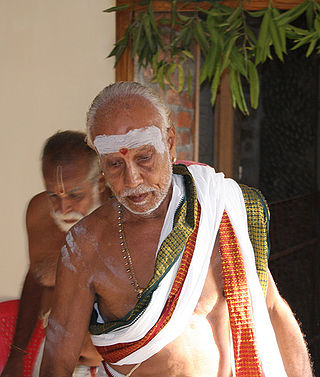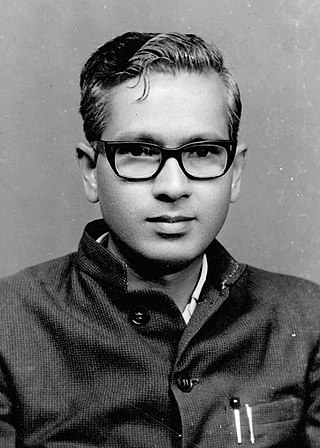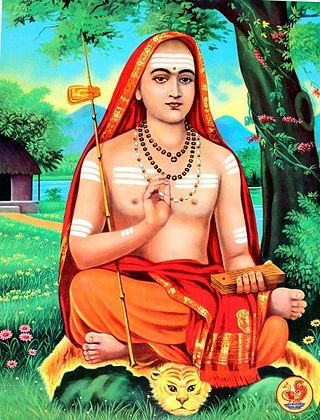Related Research Articles

Iyers are an ethnoreligious community of Tamil-speaking Hindu Brahmins. Most Iyers are followers of the Advaita philosophy propounded by Adi Shankara and adhere to the Smarta tradition. This is in contrast to the Iyengar community, who are adherents of Sri Vaishnavism. The Iyers and the Iyengars are together referred to as Tamil Brahmins. The majority of Iyers reside in Tamil Nadu, India.
Havyaka Brahmins also and originally called Havika Brahmana are a Hindu Brahmin community native to districts of Shivamogga, Uttara Kannada, Dakshina kannada and coastal Karnataka, and the Kasaragod district of Kerala. Havyakas are known by their unique culture and language. They fall under the Pancha-Dravida Brahmin category are followers in general of mostly Yajurveda and some Rigveda and Samaveda Shakas. They follow the Advaita philosophy propounded by Adi Shankaracharya.
Sankethi is a South Dravidian language that is closely related to Kannada and Tamil. It is sometimes considered a dialect of Kannada or Tamil, but there are considerable differences that make it unintelligible to speakers of both languages. It has strong lexical influences from Kannada, as well as borrowings from Sanskrit. It is most commonly spoken in Karnataka, India by the Sankethi people, who migrated from Sengottai in Tamilnadu.
Deshastha Brahmin is a Hindu Brahmin subcaste mainly from the Indian state of Maharashtra and North Karnataka. Other than these states, according to authors K. S. Singh, Gregory Naik and Pran Nath Chopra, Deshastha Brahmins are also concentrated in the states of Telangana (which was earlier part of Hyderabad State and Berar Division), Andhra Pradesh and Madhya Pradesh (Which was earlier part of Central Provinces and Berar) Historian Pran Nath Chopra and journalist Pritish Nandy say, "Most of the well-known saints from Maharashtra, Karnataka and Andhra Pradesh were Deshastha Brahmins". The mother tongue of Deshastha Brahmins is either Marathi, Kannada or Telugu.

A matha, also written as math, muth, mutth, mutt, or mut, is a Sanskrit word that means 'institute or college', and it also refers to a monastery in Hinduism. An alternative term for such a monastery is adheenam. The earliest epigraphical evidence for mathas related to Hindu-temples comes from the 7th to 10th century CE.
Telugu Brahmins are Telugu-speaking Brahmin communities native to the Indian states of Andhra Pradesh and Telangana. They fall under the Pancha Dravida Brahmin classification of the Brahmin community in India. Telugu Brahmins are further divided into sections like Vaidiki, Niyogi, Deshastha, Dravida and Golkonda Vyapari.

Tigalari, also known as Tulu script, is a Southern Brahmic script which was used to write Tulu, Kannada, and Sanskrit languages. It was primarily used for writing Vedic texts in Sanskrit. It evolved from the Grantha script. It is called as Tigalari lipi in Kannada-speaking regions and Tulu speakers call it as Tulu lipi. It bears high similarity and relationship to its sister script Malayalam, which also evolved from the Grantha script.

Mattur is a village in Shivamogga district near the city of Shivamogga in Karnataka state, India, known for the usage of Sanskrit for day-to-day communication, although the general language of the state is Kannada. Mattur is known for Sanskrit Speaking Village of India. Their native language is Sankethi. Sankethi language is a mixure of Sanskrit, Tamil, Telugu and Kannada.
The Shivalli Brahmins are a Hindu Brahmin community in Karnataka. They are divided into two groups, the first of who follow the Dvaita philosophy founded by the Vaishnava saint Madhvacharya of Udupi are called Shivalli Madhva Brahmins, and the second of who follow the Advaita philosophy of Adi Shankara are known as Shivalli Smartha Brahmins. Majority of Shivalli Brahmins are Madhvas and only a few of them are Smarthas.
Udupi cuisine is a cuisine of South India. It forms an important part of Tuluva cuisine and takes its name from Udupi, a city on the southwest coast of India in the Tulunadu region of the state of Karnataka. Udupi cuisine is strictly vegetarian and has its origin in the Udupi Sri Krishna Matha founded by Madhvacharya. The cuisine was developed by Madhva Brahmins to offer different kinds of food to Krishna at the Udupi Krishna Temple. Hence, Udupi cuisine is also synonymously known as Madhva cuisine.

Melukote in Pandavapura taluk of Mandya district, Karnataka, in southern India, is one of the sacred places in Karnataka.It is built on rocky hills, known as Yadugiri, Yaadavagiri or Yadushaila, overlooking the Cauvery valley. Melukote is about 51 km from Mysore and 133 km (83 mi) from Bangalore.
Gaud Saraswat Brahmins (GSB) are a Hindu Brahmin community, who are part of the larger Saraswat Brahmin community that migrated to Konkan from Gaud, as per the Skanda Purana in ancient India. They belong to the Pancha Gauda Brahmins group. They primarily speak Konkani and its various dialects as their mother tongue.
Brahmin Tamil is the name of a dialect of Tamil traditionally spoken by Tamil Brahmins. The dialect, largely, uses Classical Tamil along with a heavy proportion of Sanskrit derivatives. According to the linguist Sabari Ganesh, Brahmin Tamil dialect is closest to the Central Tamil dialect, particularly, the variant spoken by the once dominant and highly educated community colloquial spoken Tamil of Vellalars and Mudaliyars.

Kudaldeshkar Gaud Brahmin is a community hailing from the western coast of India, residing in the Konkan division of Maharashtra and Goa. This community is also known as Kudaldeshkar Aadya Gaud Brahmin, Kudaldeshkar and sometimes Kudalkar Brahmins. They speak Marathi, Malwani dialect of Konkani.

Togere Venkatasubbasastry Venkatachala Sastry, commonly known as T. V. Venkatachala Shastry, is a Kannada-language writer, grammarian, critic, editor and lexicographer. He has authored in excess of 100 books, translations and has edited collections of essays, biographical sketches and felicitation volumes. Recipient of the Kannada Sahitya Akademi Award (honorary), Sastry is an authority on Kannada language grammar and its various facets ranging from the metre scale on which he has written extensively to the history of Kannada literature spanning two millennia.

Madhva Brahmins, are Hindu Brahmin communities in India, who follow Sadh Vaishnavism and Dvaita philosophy propounded by Madhvacharya. They are found mostly in the Indian states of Karnataka, Maharashtra, Goa, Tamil Nadu, Kerala, Telangana and Andhra Pradesh.

The Babburkamme are a community of Brahmins in India. They are Pancha Dravida Smartha Brahmins. They have been holding highly politically influencing position such ministers, chief priests, scholars and poets under different kingdoms. A related community are today known as Uluchukamme has Kannada as their mother tongue.
Sree Pushpakabrahmana Seva Sangham (SPSS) is a registered charitable organisation which works for the progress of Pushpaka Brahmins, a group of culturally identical Brahmin castes like Pushpaka Unnis, Theeyatt Unnis, Kurukkals, Nambeesans etc. in Kerala.

Honnali Tipperudraswamy (3 February 1928 – 28 October 1994) was an Indian scholar and writer of Kannada literature. He wrote political history, religious realities and cultural aspects. He has written a few biographies meant for children on the lives of Kannada poets and Veerashaiva saints. He has made contributions to literary criticism and modern literature.
Koteshwara Brahmins are a Hindu Brahmin subcaste mainly from the Indian state of Karnataka. The community is mainly concentrated in the Koteshwara, Kundapur, and surrounding areas of Udupi district in Karnataka. The community takes its name from the village Koteshwara, which is their native place. Koteshwara Brahmins follows the Dvaita Vedanta propounded by Madhvacharya and are followers of Sodhe Vadiraja Swami Matha.
References
- ↑ Satish, DP. "Karnataka: Brahmins Sacrifice Sheep, Drink Country Liquor at Yajna". News18.
- 1 2 Ramachandran, C. N. (16 June 2011). "Trailing a tiny bunch". The Hindu. ISSN 0971-751X . Retrieved 26 August 2018.
- ↑ Nagaraja, K.S. (1982). "Tense in Sanketi Tamila Comparative Note". Bulletin of the Deccan College Research Institute. 41: 126–129. JSTOR 42931419.
- ↑ Chatterjee, Rajeswari (2003). Lifescapes of India: Religions, Customs, and Laws of India (PDF). Frandsen Humanities Press. p. 45. Archived from the original (PDF) on 26 December 2013. Retrieved 26 December 2013.
- ↑ Keshaviah, M (1936). Life of Nacharamma (History of Her Migration). Sree Panchacharya Electric Press. p. 44.
- ↑ Keshaviah, M. (1936). Life of Nacharamma (History of Her Migration). Sree Panchacharya Electric Press. p. 74.
- ↑ Pranatarthiharan, B.S. (2010). ಸಂಕೇತಿ: ಒಂದು ಅಧ್ಯಯನ (Sankethi: A Study). Samudaya Adhyayana Kendra.
- ↑ Viswanathan, Trichur S. (4 April 2013). "Tale of two villages". The Hindu. ISSN 0971-751X . Retrieved 26 August 2018.
- ↑ "NASA - Fostering the global Sankethi community". www.sankethi.org. Retrieved 26 August 2018.
- ↑ "Mysore's visionaries". Deccan Herald. 17 September 2012. Retrieved 31 August 2018.
- ↑ Pranatarthiharan, B.S. (2010). ಸಂಕೇತಿ: ಒಂದು ಅಧ್ಯಯನ (Sankethi: A Study). Samudaya Adhyayana Kendra. pp. 171–173.
- ↑ Pranatartiharan, B.S. (2010). ಸಂಕೇತಿ: ಒಂದು ಅಧ್ಯಯನ (Sankethi: A Study). Samudaya Adhyayana Kendra. pp. 173–175.
- ↑ Pranatartiharan, B.S. (2010). ಸಂಕೇತಿ: ಒಂದು ಅಧ್ಯಯನ (Sankethi: A Study). Samudaya Adhyayana Kendra. pp. 176–177.
- ↑ Pranatartiharan, B.S. (2010). ಸಂಕೇತಿ: ಒಂದು ಅಧ್ಯಯನ (Sankethi: A Study). Samudaya Adhyayana Kendra. p. 177.
- ↑ Pranatartiharan, B.S. (2010). ಸಂಕೇತಿ: ಒಂದು ಅಧ್ಯಯನ (Sankethi: A Study). Samudaya Adhyayana Kendra. p. 173.
- ↑ Pranatartiharan, B.S. (2010). ಸಂಕೇತಿ: ಒಂದು ಅಧ್ಯಯನ (Sankethi: A Study). Samudaya Adhyayana Kendra. p. 15.
- ↑ Adukale, Adukale (18 February 2021). "Sankethi Cuisine: The Lost Fare of Karnataka". Adukale. Retrieved 28 October 2023.